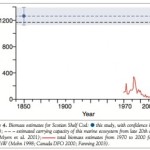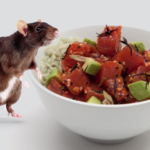
I only eat anchovies with Caesar salad, and am rather fond of the tiny fish that add a bit of strong flavor to the romaine lettuce. I’m unusual for wanting to get even that close to the tiny, oily fish – sardines, anchovy, menhaden – that used to be a staple of regular American food. That’s why Julia Whitty’s recent article in Mother Jones in which she encourages consumers to pause before they ” take a bite of that sardine sandwich” was so surprising. You won’t find sardines anywhere on the list of the top 10 consumed seafoods – or do you? Here’s why eating more sardines directly would actually be good for the ocean:
1) The United States Pacific sardine fishery is not overfished. This may be surprising to people who are familiar with the famous collapse of the Monterey (central California) sardine fishery, which was described by John Steinbeck in his book Cannery Row. Puzzlement over this collapse launched one of the most important long-term oceanographic investigations of all time, the California Cooperative Oceanic Fisheries Investigation, which continues to provide critical scientific information to this day. Over 50 years of investigation has shown that this crash actually WASN’T caused by overfishing – at least not directly.
Sardine and anchovy populations are actually tied directly to large-scale climatic conditions – if they’re favorable, there’s lots of fish. If they’re unfavorable, the fish crash. Overfishing may have exacerbate the crash and slowed recovery, but it probably didn’t cause it directly. Some researchers are predicting a similar sardine crash this year due to unfavorable climatic conditions similar to those seen before the late 1940s crash, and are encouraging managers to decrease sardine quotes in order to speed post-crash recovery. (Though this is controversial – see this response).
Historically, sardine & anchovy fisheries in other parts of the world, such as the South American anchoveta fishery (the biggest fishery in the world) are less well regulated. Overfishing in these ecosystems leads to no room for error – if there is the slightest change in the climate that causes the fish to reproduce less fast, the fishery crashes. Buy U.S. Pacific sardines.
2) Americans should eat more sardines directly, and fewer sardines indirectly. Only about a quarter of the enormous U.S. sardine haul is eaten directly – the rest are sold as bait or as fishmeal. All of the three most popular U.S. seafoods – shrimp, salmon, and canned tuna – are farmed with fishmeal or caught with bait. This is why Jennifer Jacquet developed her “Eat Like A Pig” campaign. Grist covered this issue in response to Whitty’s article as well:
Geoff Shester, the California program director at Oceana, talked to Grist contributor Clare Leschin-Hoar for the article, “Small fish, big ocean: Saving Pacific forage fish.” We followed up with him to ask his take on sardine-eating. In the case of Pacific sardines, he said that “the lion’s share go to bluefin tuna farms (ranches) in Australia, then to commercial longline bait in international tuna fisheries.” Overall, he says, “consumers are demanding the wrong things. Instead of demanding farmed salmon, which uses at least three pounds of forage fish to get one pound of salmon, people should be demanding the forage fish themselves.”
Also, sardines are healthy! They appear on the New York Times list of the 11 Best Foods You Aren’t Eating. Also, food writer Michael Pollan’s Rule 32 (Don’t overlook the oily little fishes”) elaborates further:
Wild fish are among the healthiest things you can eat, yet many wild fish stocks are on the verge of collapse because of overfishing. Avoid big fish at the top of the marine food chain–tuna, swordfish, shark–because they’re endangered, and because they often contain high levels of mercury. Fortunately, a few of the most nutritious wild fish species, including mackerel, sardines, and anchovies, are well managed, and in some cases are even abundant. Those oily little fish are particularly good choices. According to a Dutch proverb: “A land with lots of herring can get along with few doctors.”
3) Since sardine and other small forage fish like anchovies and menhadan congregate in single-species schools in the water column (see the awesome photo by Jon Bertsch at the top of this post!), there’s relatively little bycatch. Fishers are able to catch these fish, and only these fish, without accidentally killing a lot of other marine life. This is emphatically not the case with the longline tuna fisheries for which forage fish become bait. Fish farming operations have other significant environmental impacts, such as the infection of wild salmon stocks with farmed salmon parasites and damage to the ocean bottom communities. Eating sardines directly is far better for the ocean environment than filtering them through large predators caught accidentally with more large predators.
After the beating I took on bluefin tuna, I feel that I need to say that I am a marine biologist but not a fisheries scientist. A blog post can’t be a critical, comprehensive review of fisheries populations models, since a) nobody would read that and b) I actually do have a day job. But I love eating fish and reading scientific literature, so I keep writing on these issues in the attempt to make complex issues more accessible to the general public. Because when super-lefty-enviro magazines Grist and Mother Jones disagree, what the heck is a consumer to do?
Anyway, a sardine sandwich sounds super gross. Before you eat some sustainable tasty Pacific sardines, check out Barton Seaver’s website for far more tasty ways to eat them.






You’re making me remember the first time I was served whole grilled sardines in Portugal. It was a revelation, but I have not been able to find its like here.
When I saw the title of this post in my RSS feed, I was hoping this would be your answer…eat the sardines themselves, not the fish we usually grind them up and feed them to!
@jebyrnes: I had a similar conversion experience the first time I was fed fresh sardines. I’ve found them in Whole Foods once, and at the Asian market Uwajimaya in Seattle. I’ve also found them at The Walrus and the Carpenter, and Harvest Vine, also in Seattle. Any restauranteurs reading this…moar sardinz plz!
Or… what about just NOT EATING SARDINES (or any marine seafood) AT ALL? Wouldn’t that be even better for the ocean ecosystems (both directly AND “indirectly”)??
Thanks, you do a good job of covering this issue. The Pacific Fishery Management Council manages sardine fisheries off the West Coast – people can learn more about how the fishery is managed at http://www.pcouncil.org/coastal-pelagic-species/background-information/.
Thanks for writing this, Miriam! Great job hitting so many nails on the head!
@jebyrnes, I see you are from Santa Barbara, so am I! Luckily it is very easy to catch them anywhere around the harbor here. You can see sea lions, gulls, cormorants and pelicans all around the harbor enjoying them, and you should too! Stay tuned to http://www.EatUSSeafood.com for a step-by-step do-it-yourself guide on how to catch, prepare and eat these tasty little guys!
Where do smelts fit into all of this? Deep-fried smelts are like my favorite thing to eat at a seafood shack.
And sardine sandwiches are good if you have good bread and good butter and the sardines are the nice kind, in olive oil with herbs or pepper. This Bittman recipe is also not bad in a pinch, though a bit dry: http://www.nytimes.com/2010/03/31/dining/31minirex.html
HI Philip,
I actually don’t think that would be better for the ocean. Seafood is the last wild food most of us eat, and it ties us directly to a fairly alien environment. Also, people have to get their protein from somewhere, and it’s far better to get it directly from sardines than from chickens or cows that have been fed sardine fish meal. We CAN fish sustainably – we just need to get economic and cultural forces to align properly.
Smelt is sort of a catch-all term for a lot of little baitfish, and in general these are really good environmental choices for the same reasons that sardines are – low on the food chain, little bycatch, not overfished. I’ve never had them but I’ll eat anything fried, and all the better if it’s tasty fish.
Thanks for the sardine sandwich tip! I’ll have to give it a try.
Jarrett points to a real problem–fresh sardines are delicious, but damned hard to find in US seafood shops. Any tips where to find them, either in the Boston area, or in general?
As for canned, I am srsly hooked (yok yok yok) on Trader Joe’s smoked herring. I’m hoping that as an OLBF, the good stuff you say above about sardines applies similarly to herring. What say you?
A key response to the “What if we didn’t eat marine life?” question posed by Phillip T. above is answering, “What would we eat instead?” (As an aside, ecologists do not ask the “What would happen instead?” question nearly enough….) Since the answer is certainly not, “Nothing…” and probably “Chicken!”/”Beef!”/”Pork…mmm…bacon!” for most of us, we have to ask whether those are better or worse for the environment. According to follow-up work on http://www.seafoodindustry.co.nz/f464,107558/107558_ECNZFP_2012.pdf that I saw presented the other day, sardinella are the best sources of protein per unit environmental cost on most dimensions. In fact, even vegetarians need to step off the environmental high horse here: fertilizer on soybeans and other vegetable protein sources contribute significantly to oceanic dead zones. Significantly enough so that if you pose the question, “What can I eat that has the least environmental impact?” for most standard definitions of “environmental impact,” the answer comes back: sardines. Eat them up. Yum!
It looks like sardines are more a European thing to eat than an American. The already mentioned grilled Sardines in Portugal (delicious!!!). They have something similar in Spain. In Germany it’s Kieler Sprotten. In Italy, you put sardines + olives + peppers on pasta, toss it with a bit of olive oil and eat it with a great wine! So many ways to eat them.
But does anybody have input on the state of sardine populations in the Atlantic? I would be highly interested!
Thanks!
I think you’re right overall, Miriam. Julia Whitty is also right in Mother Jones…she’s just looking from a fairly narrow perspective.
I’ve always wondered why Americans are so afraid of eating fish that actually tastes like fish, and unfortunately that determines what seafood is actually available at the market. Anchovies, sardines, bluefish… nobody wants these (perfectly tasty) fish, but we overfish the comparatively less-flavorful cod to the brink of extinction. At least I can feel good about liking anchovy pizza.
Hey Vinnie,
My go-to source for seafood sustainability information is Seafood Watch. They have free apps for Android and iPhone too, so you can easily look stuff up in the store. Herring is indeed a forage fish (OLF) like sardines, and relatively well managed (though there are some concerns) but I would say eat herring without guilt.
Incidentally, Trader Joe’s, despite all the organic stuff it sells, has a TERRIBLE record on seafood sustainability (though they’ve promised to get better) – so use caution, or better yet, write them and tell them that you care about sustainable seafood sourcing.
Man, I’ve tried SO HARD to like bluefish, since they’re so fun to catch, but eating an entire oily filet….I just can’t do it. Maybe I’m just not preparing it right.
That NY Times list is sooo pseudoscientific. It’s packed with “may be ” “cancer fighting” (usually just in vitro if at all) and the old antioxidant hype (if you want to know more about that part, just look at the science based medicine blog).
You definitely have to remove the red strip from the fillet before you do anything. I’ve had good luck grilling bluefish, and it’s not bad fried either.